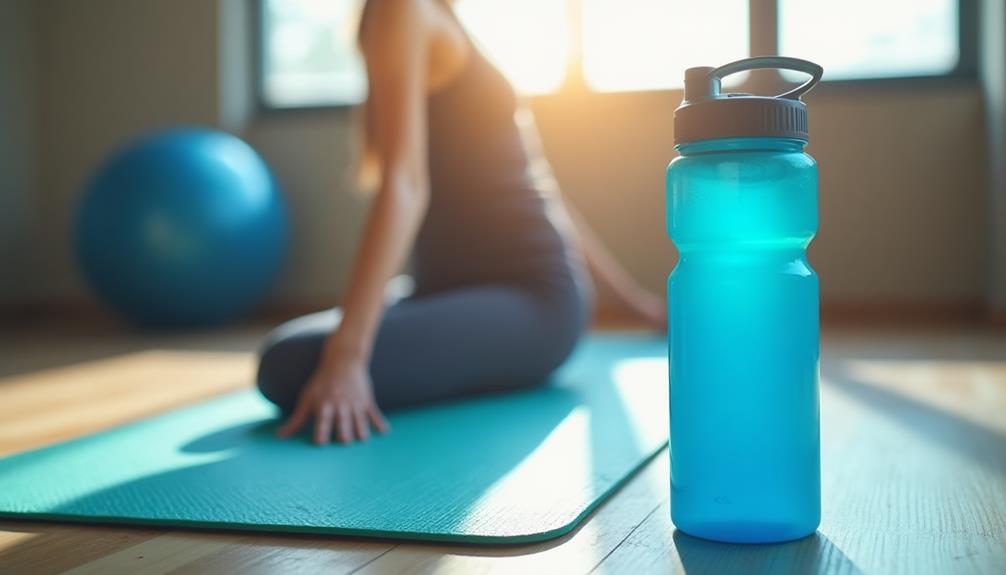To heal your muscles after high-intensity training, focus on these essential tips. Hydrate well; water aids in transporting nutrients and removing waste. Prioritize Nutrition; include protein for muscle repair, healthy fats to reduce inflammation, and carbs to replenish energy stores. Incorporate Active Recovery; low-intensity exercises like walking can boost blood flow and aid recovery. Utilize Foam Rolling; it helps release tension and promote blood circulation. Implement Stretching Techniques; stretch post-workout to improve flexibility and reduce stiffness. Lastly, make sure you get quality sleep. Following these strategies can greatly enhance your recovery process, setting you up for your next workout.
Core Insights
- Prioritize hydration by drinking water and electrolyte drinks to support nutrient transport and waste removal post-workout.
- Consume a balanced meal with protein, healthy fats, and carbohydrates to aid muscle repair and replenish energy stores.
- Incorporate active recovery activities like walking or cycling to enhance blood flow and reduce muscle soreness.
- Utilize foam rolling for 10-15 minutes after workouts to relieve muscle tension and promote blood circulation.
- Implement static and dynamic stretching to improve flexibility and reduce muscle stiffness after intense training.
Prioritize Hydration

When you push your body to its limits during high-intensity training, staying hydrated is crucial for muscle recovery. Water plays a significant role in nutrient transport, waste removal, and temperature regulation. When you sweat, you lose not only water but also essential electrolytes, which are necessary for muscle function. Coconut water brands can be an excellent natural source of electrolytes, offering high potassium content and minimal added sugars. Some options even include additional vitamins to support overall health and recovery.
To maximize your recovery, aim to drink water before, during, and after your workouts. Consider incorporating electrolyte drinks if your sessions are particularly long or intense. Monitor your hydration levels by checking the color of your urine; light yellow indicates proper hydration.
Focus on Nutrition

Here's a quick breakdown of essential nutrients:
| Nutrient | Function |
|---|---|
| Protein | Repairs and builds muscle |
| Healthy Fats | Reduces inflammation |
| Carbohydrates | Replenishes glycogen stores |
| Vitamins & Minerals | Supports overall recovery |
Incorporating these nutrients into your post-workout meals will enhance recovery and prepare you for your next training session. Don't forget to keep your meals balanced and varied for best outcomes.
Incorporate Active Recovery

Nutrition plays an essential role in recovery, but incorporating active recovery into your routine can further enhance muscle healing after high-intensity training. Active recovery involves low-intensity exercises that promote blood flow and help flush out toxins. Think walking, cycling, or light swimming. Topical magnesium sprays can also be beneficial for muscle recovery, providing localized relief and supporting overall muscle function.
Aim for 20 to 30 minutes of these activities a few days a week, ideally on your rest days. This approach not only aids in muscle repair but also reduces soreness and stiffness.
Listening to your body is key—if you feel fatigued, adjust the intensity accordingly. By making active recovery a consistent part of your regimen, you'll support your muscles' healing process, enhance your overall performance, and set yourself up for future training success.
Utilize Foam Rolling

Foam rolling is a powerful tool for muscle recovery that can greatly enhance your post-workout routine. By applying pressure to tight muscles, you promote blood flow and help release tension. Start by choosing a foam roller that suits your needs—thicker rollers provide more pressure, while softer ones are gentler. For added relief, consider incorporating cooling towels into your recovery process, as they can help reduce muscle temperature and inflammation.
Begin rolling slowly over your muscles, focusing on areas that feel particularly tight. Spend 30 seconds to a minute on each spot, allowing the roller to do its work.
Remember to breathe deeply as you roll, which can help relax your muscles further. Aim to foam roll for 10-15 minutes after your workouts. This practice can aid in reducing soreness and improving your overall muscle recovery, keeping you ready for your next session.
Implement Stretching Techniques

In addition to foam rolling, implementing effective stretching techniques is essential for muscle recovery after high-intensity training. Stretching helps improve flexibility, increases blood flow, and reduces muscle stiffness, promoting quicker recovery.
Types of Stretching:
- Static Stretching: Focus on holding a stretch for 15-30 seconds. Target major muscle groups like hamstrings, quads, and shoulders.
- Dynamic Stretching: Incorporate movements that mimic your training. This prepares your muscles and joints for activity while aiding recovery.
When to Stretch:
Try to stretch after your workout when your muscles are warm. This maximizes the benefits and helps prevent injuries.
Get Quality Sleep

A consistent sleep schedule can greatly enhance your recovery process. Go to bed and wake up at the same time daily to regulate your body's internal clock. Create a calming bedtime routine, like reading or meditating, to signal your body it's time to wind down.
Avoid screens and caffeine before bed, as they can interfere with your sleep quality. Prioritizing sleep can notably improve your performance in the long run.
Consider Massage Therapy

Massage therapy can be a powerful tool for enhancing recovery after intense training. It helps to increase blood flow, which can reduce muscle soreness. By loosening tight muscles, it aids in improving flexibility and range of motion. You'll find that targeted massage techniques can alleviate tension and promote relaxation.
Consider scheduling a session with a qualified therapist who understands sports recovery. They can tailor the treatment to your specific needs, focusing on areas that feel particularly strained. Regular sessions can also help prevent injuries by keeping your muscles in top condition. So, whether it's a deep tissue massage or a lighter technique, incorporating massage into your recovery routine can greatly enhance your overall performance and well-being.
Monitor Your Progress

| Metric | Observation |
|---|---|
| Muscle Soreness | Decreases over time |
| Sleep Quality | Improves with recovery |
| Workout Intensity | Can be adjusted weekly |
| Overall Mood | Should remain stable |
Monitor these key indicators regularly. This way, you can identify trends and make necessary changes to enhance your recovery. Remember, effective monitoring not only promotes healing but also boosts your performance in future workouts.
Frequently Asked Questions
How Long Should I Wait Before Resuming High-Intensity Training?
You should wait at least 48 to 72 hours before resuming high-intensity training. Listen to your body—if you still feel sore or fatigued, give yourself more time to recover and avoid injury.
What Are the Signs of Overtraining to Watch Out For?
While you're pushing your limits, pay attention to fatigue and irritability. When energy fades and motivation dips, it's a sign to rest. Balance hard work with recovery, or you'll risk burnout and injury.
Can I Train Through Minor Muscle Soreness?
You can train through minor muscle soreness, but listen to your body. Focus on lighter workouts and recovery techniques. If pain intensifies, it's best to rest and avoid risking injury or prolonged discomfort.
Are There Specific Supplements That Aid Muscle Recovery?
Yes, certain supplements can aid muscle recovery. You might consider protein powder for muscle repair, BCAAs to reduce soreness, and omega-3 fatty acids for inflammation. Always consult a healthcare professional before starting any new supplement regimen.
How Does Stress Affect Muscle Healing After Intense Workouts?
Stress can hinder your muscle healing by increasing cortisol levels, which disrupts recovery processes. When you're stressed, your body struggles to repair, leading to prolonged soreness and fatigue. Managing stress is essential for best recovery.

